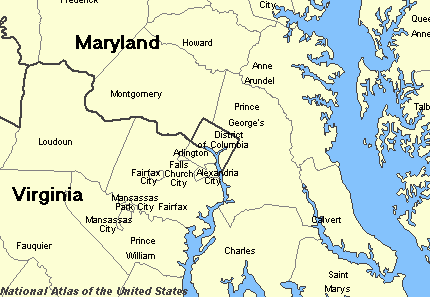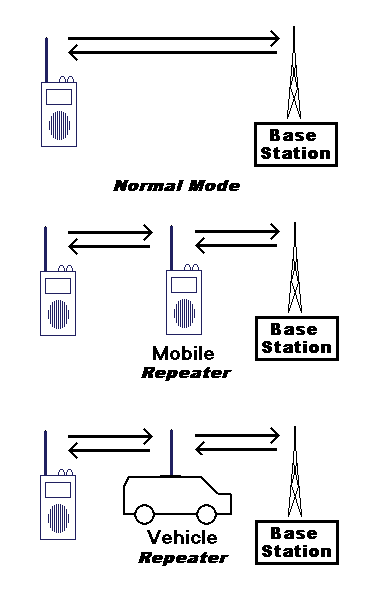| This article first appeared in the December 2003 issue of Monitoring Times. |
From the early days of crystal-controlled VHF receivers to today's microprocessor-controlled radios, scanning has evolved in scope and complexity. Despite the changes in technology, two common themes have continued to play a central role in the effectiveness of a radio system: interoperability and coverage. This month we'll take a look at two systems that typify where public safety trunked radio systems seem to be headed.
Washington, D.C.
Within the 68 square miles of the District of Columbia reside the White House, Congress, innumerable Federal agencies and half a million residents. The primary law enforcement agency in the District is the Metropolitan Police Department (MPD), which operates a Motorola trunked radio system in the UHF band. The District of Columbia Fire Department, which includes Emergency Medical Services, operates a Motorola SmartNet trunked system in the 800 MHz band.

As reported in the June 2001 Tracking the Trunks column, the 800 MHz system has been suffering from a number of "dead zones" where firefighter radios could not be heard by the nearest repeater. These zones weren't just in basements and parking garages where poor signal quality might be expected, but communication at such major locations as Union Station and the MCI Center were also unreliable.
The Fire Department instituted some patchwork solutions, including the use of cellular telephones and a policy of dispatching an extra fire engine on every call. The extra engine was there to provide radio "relay teams" who used their portable radios as repeaters, rebroadcasting the signals from personnel actually fighting the fire.
Upgrades
The good news in this story is that in October the city completed a $31 million upgrade to the radio system, using money from a $46 million Homeland Security grant received early last year.
The upgrade included six additional repeater sites and a new SmartNet network that interconnects the 800 MHz fire system with the UHF radios used by the MPD. The old UHF infrastructure was completely replaced as well as more than 1,000 old portable and mobile radios. During the upgrade, more than 60 vehicles were equipped with short-range repeaters that should greatly improve on-scene coverage.

The city now has a dual-band system with ten repeaters. Thirteen channels are available on the UHF system and sixteen on the 800 MHz system.
Interestingly, the city decided against using the APCO Project 25 standard. Their logic was that since most agencies in the metropolitan area use Motorola SmartNet systems, switching to P-25 would actually reduce interoperability with those agencies.
The city now claims that there are no longer any known dead zones, although additional work continues on the Metrorail tunnels and other underground structures.
Police
The MPD frequencies are 460.0250, 460.1000, 460.1500, 460.2000, 460.2500, 460.2750, 460.3250, 460.3500, 460.4000, 460.4250, 460.4500, 460.4750 and 460.5000 MHz. For scanner programming, use a base frequency of 458.7750 MHz and an offset of 12.5 kHz.
Decimal Hex Description
16400 401 1st District
16432 403 2nd District
16464 405 3rd District
16496 407 4th District
16528 409 5th District
16560 40B 6th District
16592 40D 7th District
16624 40F City Wide
16656 411 Command 2
16688 413 Command 1
16720 415 Command 3
16752 417 Command 4
17360 43D Special Events 1
17392 43F Special Events 1A
17424 441 Special Events 1B
17456 443 Special Events 2
17488 445 Special Events 2A
17520 447 Special Events 2B
17552 449 Special Events 3
17584 44B Special Events 3A
17616 44D Special Events 3B
17648 44F Special Events 4
17680 451 Special Events 4A
17712 453 Special Events 4B
17744 455 Field Command
17840 45B Mayor
17872 45D Inter-Agency Operations 1
17904 45F Inter-Agency Operations 1
18032 467 Emergency Communications Center A
18096 46B Emergency Communications Center B
18160 46F Emergency Communications Center C
18256 475 Fire Department 1
18288 477 Fire Department 2
18640 48D Emergency Response Team 1
18672 48F Emergency Response Team 2
18704 491 Emergency Response Team Command
18864 49B Harbor
18896 49D Aviation
18928 49F Field Operations
19728 4D1 Takoma Park (Maryland) Police
19760 4D3 Hyattsville (Maryland) Police
19824 4D7 Virginia State Police
19856 4D9 Maryland State Police
19952 4DF Arlington (Virginia) Police
19984 4E1 Alexandria (Virginia) Police
21136 529 US Park Police 1
21168 52B US Park Police 2
21200 52D US Park Police 3
21232 52F US Park Police 4
Fire
For those without a trunk-tracking scanner, Fire Dispatch is simulcast on 154.1900 MHz.
The Fire Department frequencies are 852.6125, 852.6375, 852.6625, 852.6875, 852.7125, 852.7375, 852.7625, 852.7875, 855.2125, 855.2375, 855.4625, 856.9875, 857.9875, 858.9875, 859.9875 and 860.9875 MHz.
Decimal Hex Description
1616 65 Dispatch
1632 66 Main
1648 67 Fireground 1
1664 68 Fireground 2
1680 69 Fireground 3
1904 77 Emergency Medical Services 1
1920 78 Emergency Medical Services 2
1936 79 Emergency Medical Services 3
1952 7A Emergency Medical Services 4
1968 7B Administration 1
2192 89 Administration 2
2208 8A Administration 3
2032 7F Training 1
2048 80 Training 2
2064 81 Investigations
2080 82 Inspectors
2320 91 Medstar
2640 A5 Fire Boat Operations
State of Alaska
Across the continent from Washington, D.C., the state of Alaska is working on a joint program with the Department of Defense (DoD) called Alaska Land Mobile Radio (ALMR). What's unique about this project is that instead of the state building one network and the federal government building a second system, ALMR is designed to combine state and DoD resources. In particular, the radio frequencies from the state and the federal government are being combined into a single system.
In the United States, two agencies are responsible for allocating radio frequencies. Federal government allocations are done through the National Telecommunications and Information Administration (NTIA). The Federal Communications Commission (FCC) regulates all non-federal frequencies, including state and local public safety agencies. Rarely do the agencies overlap. However, the events of September 11, 2001, and the unique characteristics of Alaska prompted the FCC to grant ALMR an official waiver, allowing it to share Department of Defense frequencies.
 As with many new radio systems, ALMR will be based on APCO Project
25 standards. The mantra here is interoperability -- those in charge
of an incident can communicate directly with those involved, regardless
of the agency they come from. Planners hope that ALMR will eventually
replace more than 100 different radio systems currently in use around
the state, allowing all of these users to be able to talk with each
other when necessary.
As with many new radio systems, ALMR will be based on APCO Project
25 standards. The mantra here is interoperability -- those in charge
of an incident can communicate directly with those involved, regardless
of the agency they come from. Planners hope that ALMR will eventually
replace more than 100 different radio systems currently in use around
the state, allowing all of these users to be able to talk with each
other when necessary.
ALMR will carry data as well as voice, allowing laptops and other computing devices to send and receive information from state databases. Voice will continue to have priority in emergency situations.
Alaska already has a network of microwave repeater sites, which are being modified to operate Project 25 compliant equipment. Build-out of the network will follow the Kenai Peninsula to Fairbanks, then to the North Slope and down to Canada along the Alaska Highway. Links from Juneau and Southeast Alaska are also in the works. ALMR will have a main control center in Anchorage. A duplicate, fully redundant center is under construction near Fairbanks.
Funding for the ALMR project comes largely from the federal government, totalling more than $30 million through the next two years. The state expects to kick in about $6 million, with the hope of a 90/10 cost-share with the federal government.
Security
With the Department of Defense and federal agencies expected to be heavy users of the system, security has taken on a larger role than in a typical public safety system. Much of the radio traffic from federal users is expected to be encrypted. ALMR plans to use the newer and (hopefully) stronger Advanced Encryption Standard (AES) algorithm for encryption, rather than the older Data Encryption Standard (DES). DES is now three decades old and is showing it's age -- with the advances in computing power that have occurred since DES was originally designed it is possible to crack DES by "brute force," where all possible decryption keys are tried in rapid succession. It is due in large measure to this weakness that the National Institute of Standards and Technology (NIST) is recommending the use of AES in place of DES. According the ALMR documentation, AES is "highly advised most for homeland defense missions and roles." It will be interesting to see if any of the public safety agencies touting encryption will follow Alaska's lead.
Future Development
Given Alaska's rugged terrain and harsh climate, some remote villages may end up being linked via satellite to a state-wide emergency broadcast system. There has also been interest from oil companies like Exxon-Mobil and Philips to join the system for their North Slope and marine operations.
ALMR has already demonstrated the ability to link up with other radio networks, including the existing Anchorage Airport 800 MHz system, the Federal Aviation Administration (FAA), and the Department of Transportation (including the Coast Guard and Highway communications systems).
The system is registered for more than a hundred frequencies between 154.6500 MHz and 156.2375 MHz, basically every 12.5 kHz (you can see the exact frequencies and repeater locations on my web site at www.signalharbor.com under the APCO 25 Frequencies selection).
For instance, in the Anchorage area the following frequencies are in use from five repeaters:
154.7125, 154.8625, 155.1125, 155.4125, 155.5625, 155.9125, 156.1375 MHz
154.8000, 154.9500, 155.3500, 155.7625, 156.1500 MHz
154.6750, 154.8250, 155.3375, 155.5125, 155.7875, 155.9875, 156.1625 MHz
154.7375, 154.8875, 155.4875, 155.6875, 155.8500, 156.0875, 156.2375 MHz
154.6625, 154.8125, 155.5875, 155.8875, 156.0375, 156.1875 MHz
And in the Fairbanks area, six repeaters are licensed for these frequencies:
154.6750, 154.8250, 154.9875, 155.5125, 155.7875, 155.9875, 156.1625 MHz
154.8625, 155.1125, 155.4125, 155.5625, 155.7125, 155.9125, 156.1375 MHz
154.7000, 154.9000, 155.4500 MHz
154.8500, 155.0250, 156.1000 MHz
154.6625, 154.8125, 154.8875, 155.4875, 155.6875, 155.8875, 155.9250, 156.0875, 156.1875, 156.2375 MHz
154.6500, 154.6875, 154.8375, 154.8750, 155.4000, 155.4625, 155.6125, 155.9000, 156.0500, 156.1250 MHz
There are also a handful of standard Interoperability channels in use:
151.1375 Highway Maintenance
154.4525 Fire
155.7525 Any Public Safety (Calling Channel)
158.7375 Police
159.4725 Forestry/Conservation
That's all the room I have this month. This also marks the end of the Tracking the Trunks column, which started three years ago with the idea that scanner listeners might want more information about these increasingly common trunked radio systems. I'm happy to say that you and your fellow readers have responded positively to the information and explanations that have appeared here and I hope we've both learned a lot along the way.
As explained elsewhere in this issue, I will be taking over the Scanning Report column beginning in January. As more agencies and municipalities upgrade their radio systems it's clear that trunking is here to stay, and a comprehensive "scanning report" needs to reflect the real world mix of conventional and trunked systems. So, keep sending those e-mails to me at danveeneman@monitoringtimes.com. My web site at www.signalharbor.com will continue to be updated with radio- and trunking-related information.
Have a Merry Christmas and Happy New Year!